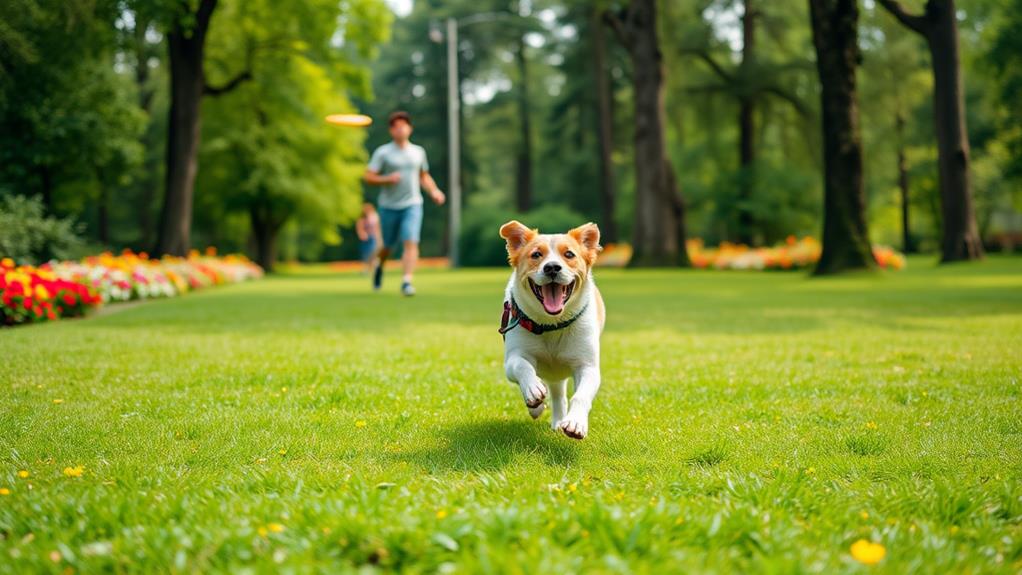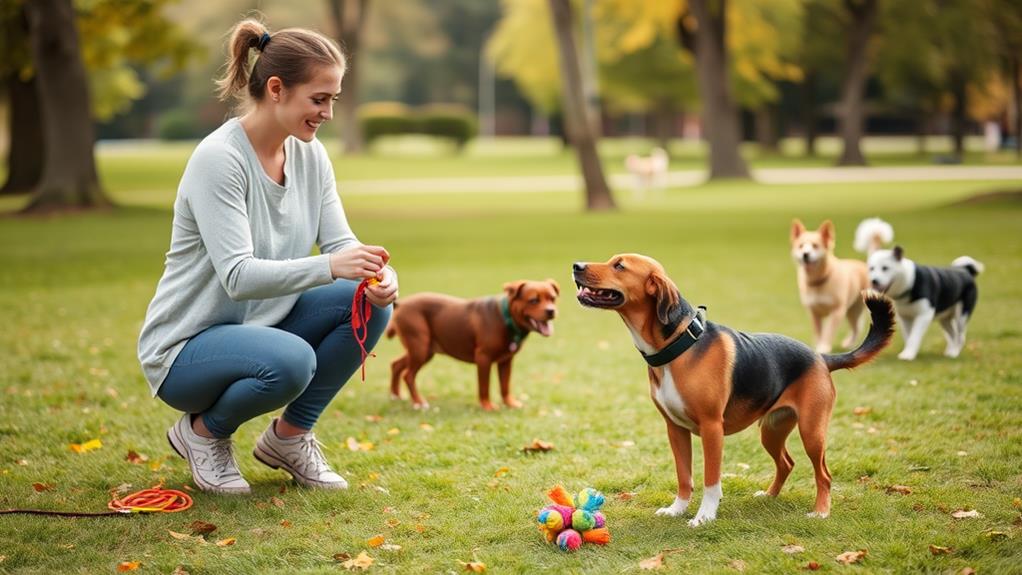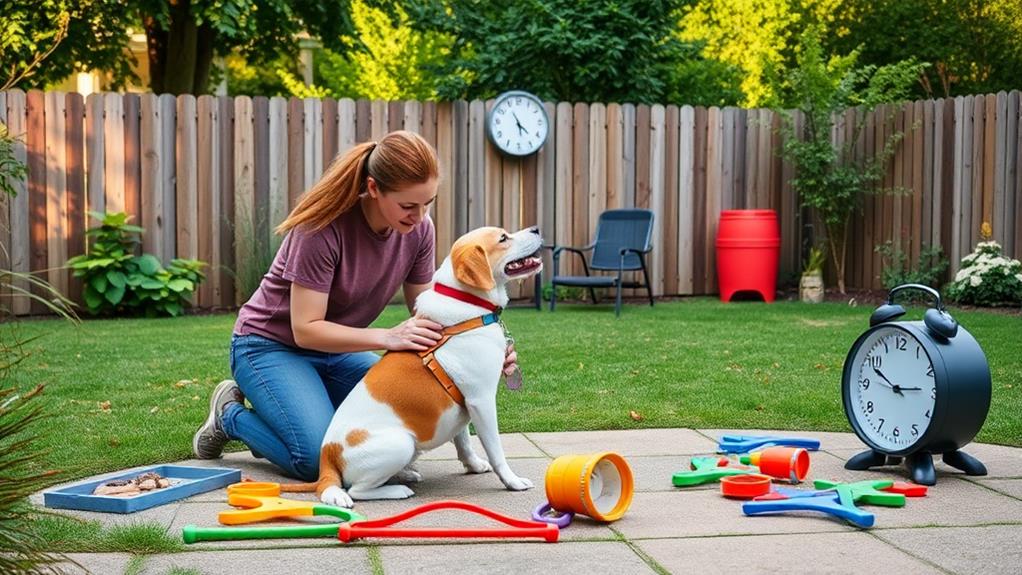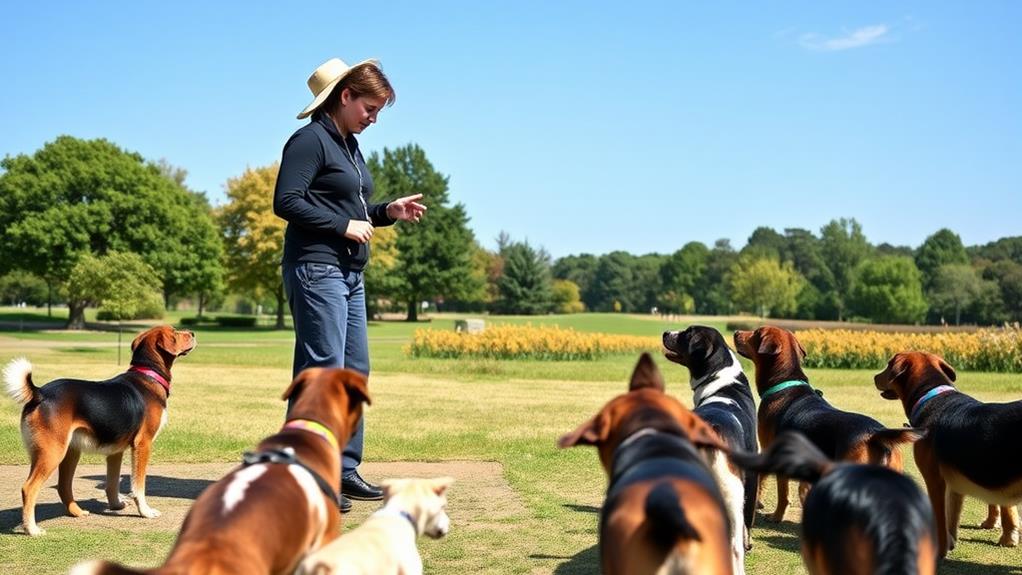To curb excessive barking, start by identifying the cause. Observe your dog's behavior to pinpoint triggers. Next, teach the "Quiet" command; say it calmly and reward your dog when they stop barking. Reinforce positive behavior consistently. Guarantee your dog gets enough exercise—aim for at least 30 minutes daily. Use distractions like toys to redirect their attention during barking episodes. Establish a predictable routine to help them feel secure. If barking persists, consider seeking professional help for tailored strategies. There are effective methods you can use, and you'll find more tips to help as you explore further.
Identify the Cause of Barking

To effectively curb excessive barking, you first need to identify the cause behind your dog's vocalizations. Start by observing your dog's behavior and the context in which the barking occurs. Is your dog barking at strangers, other animals, or even noises? Understanding these triggers is essential.
Next, consider whether your dog's barking is motivated by boredom, anxiety, or a need for attention. If your dog barks when left alone, it might be experiencing separation anxiety. On the other hand, if it barks at the mailman, that could be a territorial instinct.
Keep a diary of when and why your dog barks. Note the time, situation, and your dog's body language. This record can help you spot patterns and pinpoint specific causes.
Additionally, assess your dog's environment. Are there distractions, like passing cars or loud noises, that stimulate barking? Eliminating or minimizing these triggers can make a significant difference.
Once you've identified the cause, you'll be better equipped to address the behavior effectively, leading to a happier, quieter home for both you and your furry friend.
Teach the "Quiet" Command

Teaching your dog the "Quiet" command is a powerful tool in managing excessive barking, especially when combined with positive reinforcement techniques. Start by waiting for a moment when your dog is barking. As soon as they stop, say "Quiet" in a calm and firm voice. It's imperative to maintain a neutral tone to avoid exciting them further.
Once your dog is quiet, immediately reward them with praise or a treat. This reinforces the idea that being quiet brings positive outcomes. If your dog continues to bark, you can gently distract them by using a toy or calling their name, then repeat the "Quiet" command as they settle down.
Consistency is key; practice this command several times a day. Gradually increase the duration they must remain quiet before getting a reward. Remember, patience is indispensable. Some dogs may take longer than others to grasp the command.
If your dog barks during specific situations, like when someone approaches the door, practice the "Quiet" command in those contexts. With time and persistence, your dog will learn that being quiet is desirable, helping to reduce their excessive barking overall.
Reinforce Positive Behavior

Reinforcing positive behavior is an essential part of reducing excessive barking. Whenever your dog remains quiet, especially in situations where they usually bark, it's pivotal to reward them immediately. This can be done with treats, praise, or playtime. The key is to make sure they associate being quiet with positive outcomes.
Start by observing your dog's triggers. If they typically bark at the mailman, wait until they're calm during the delivery. When they don't bark, offer a reward. This teaches them that silence yields rewards, while barking doesn't.
Consistency is indispensable. Make sure everyone in your household follows the same reinforcement strategy. If one person rewards barking while another reinforces silence, it'll confuse your dog and hinder progress.
Use a clicker or a specific word like "yes" to mark the behavior you want to reinforce. This helps your dog understand exactly what they did right. Over time, gradually increase the duration of silence required before giving the reward.
Provide Sufficient Exercise

Providing sufficient exercise can markedly reduce your dog's barking by helping them burn off excess energy. When dogs don't get enough physical activity, they can become restless and anxious, leading to increased barking. Aim for at least 30 minutes to an hour of exercise each day, depending on your dog's age, breed, and energy level.
Incorporate a variety of activities to keep things interesting. Daily walks are essential, but consider adding playtime, such as fetch or tug-of-war. If your dog enjoys the water, swimming can be an excellent way to tire them out. Socializing with other dogs at a dog park can also provide both exercise and mental stimulation.
Don't forget about engaging their minds as well. Puzzle toys and training sessions can complement physical exercise, keeping them mentally occupied and less likely to bark out of boredom.
Use Distractions Wisely

After your dog gets plenty of exercise, distractions can be a powerful tool to curb excessive barking. You'll want to identify what triggers your dog's barking—be it doorbells, passing cars, or other animals. Once you know the triggers, you can introduce distractions that redirect their attention.
Toys, treats, or engaging games can be effective. For instance, when your dog begins barking at a stimulus, immediately present a favorite toy or a treat. This not only interrupts the barking but also reinforces positive behavior.
Additionally, consider using puzzles or interactive toys that require focus and mental stimulation. These can keep your dog occupied, reducing the chances of barking at outside distractions.
Teach commands like "leave it" or "quiet," and pair these with distractions. When your dog responds correctly, reward them with praise or a treat. Consistency is key; the more you practice this, the more your dog will learn to associate distractions with positive outcomes.
Using distractions wisely will help your dog understand when barking is unnecessary and encourage calmer behavior over time.
Establish a Routine

A consistent routine can considerably reduce your dog's excessive barking. Dogs thrive on predictability, so establishing a daily schedule will help them feel secure and less anxious. When your dog knows what to expect, they're less likely to bark out of boredom or confusion.
Here's a simple routine you can follow:
| Time | Activity | Duration |
|---|---|---|
| 7:00 AM | Morning walk | 30 minutes |
| 8:00 AM | Breakfast | 15 minutes |
| 9:00 AM | Playtime | 1 hour |
Seek Professional Help

Sometimes, enlisting the help of a professional dog trainer can be the most effective way to curb excessive barking. Trainers have the expertise to assess your dog's behavior and understand the underlying causes of their barking. They can provide tailored strategies that fit your dog's personality and your lifestyle.
When you seek professional help, you gain access to proven methods and techniques that you mightn't know about. A trainer can teach you how to communicate better with your dog, helping them understand what's expected. Additionally, they can guide you through the training process, ensuring consistency and effectiveness in your approach.
Choosing the right trainer is fundamental. Look for someone with positive reinforcement techniques, as these are more effective and humane. Ask for recommendations, read reviews, and don't hesitate to ask potential trainers about their experience with barking issues.
Frequently Asked Questions
What Breeds Are More Prone to Excessive Barking?
Certain breeds, like Beagles, Dachshunds, and Yorkshire Terriers, tend to bark more. Their natural instincts and high energy levels often lead to excessive vocalization, especially if they're bored or lack proper training and stimulation.
Can Barking Indicate an Underlying Health Issue?
Yes, barking can signal an underlying health issue. If your dog's barking suddenly increases or changes, it's important to observe their behavior and consult a veterinarian to rule out any potential medical concerns.
How Long Does It Take to See Results?
Seeing results from your training can feel like waiting for a flower to bloom. Typically, you'll notice improvements within a few weeks, but consistency and patience are key to achieving lasting change in your dog's behavior.
Are There Tools to Help With Training?
Absolutely, you've got several tools to assist with training. Consider clickers, treat dispensers, and training collars. Each can enhance your process, making it easier for you to communicate effectively with your dog and reinforce good behavior.
What Should I Avoid During Training Sessions?
During training sessions, avoid distractions like loud noises or other pets. Don't lose your patience; frustration can hinder progress. Stay consistent and calm, or your dog might not grasp what you're trying to teach.
Conclusion
By identifying the cause of your dog's barking, teaching the "quiet" command, and reinforcing positive behavior, you create a calmer environment. By providing sufficient exercise, using distractions wisely, and establishing a routine, you promote a happier, more balanced pup. If needed, seeking professional help can further guide you on this journey. Together, these steps not only curb excessive barking but also strengthen the bond between you and your furry friend, leading to a more harmonious life.



